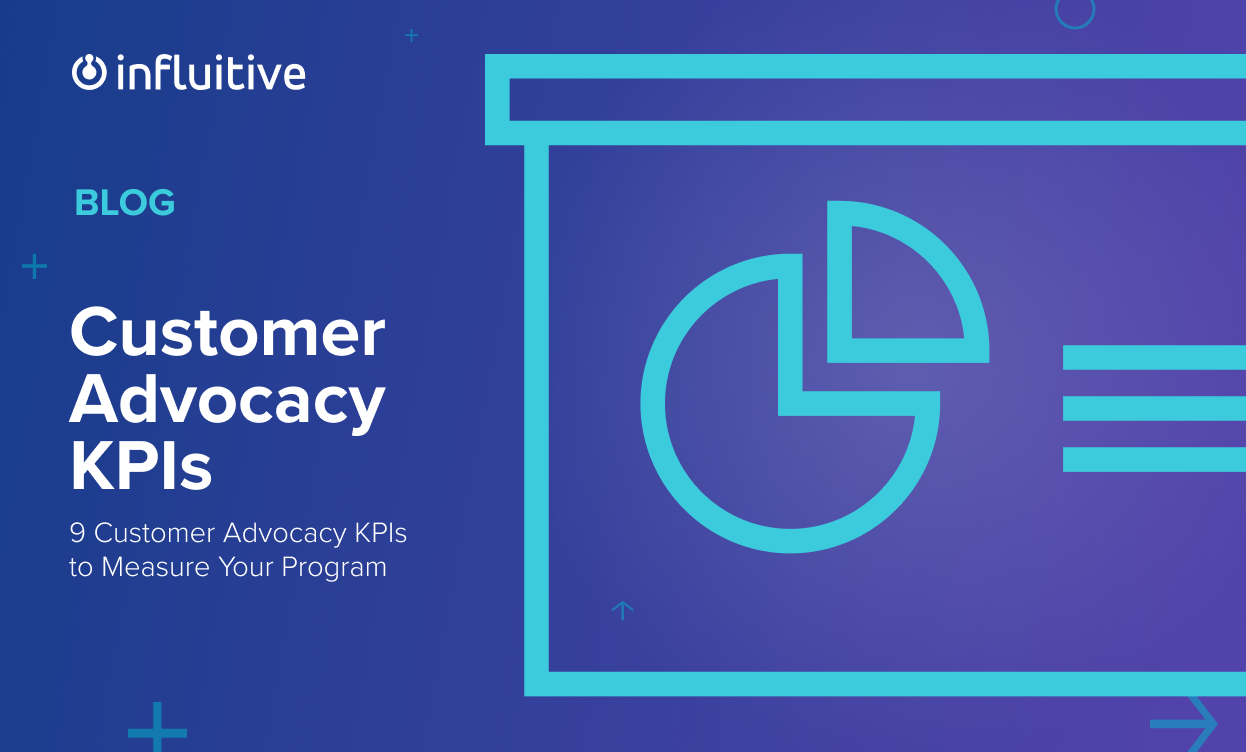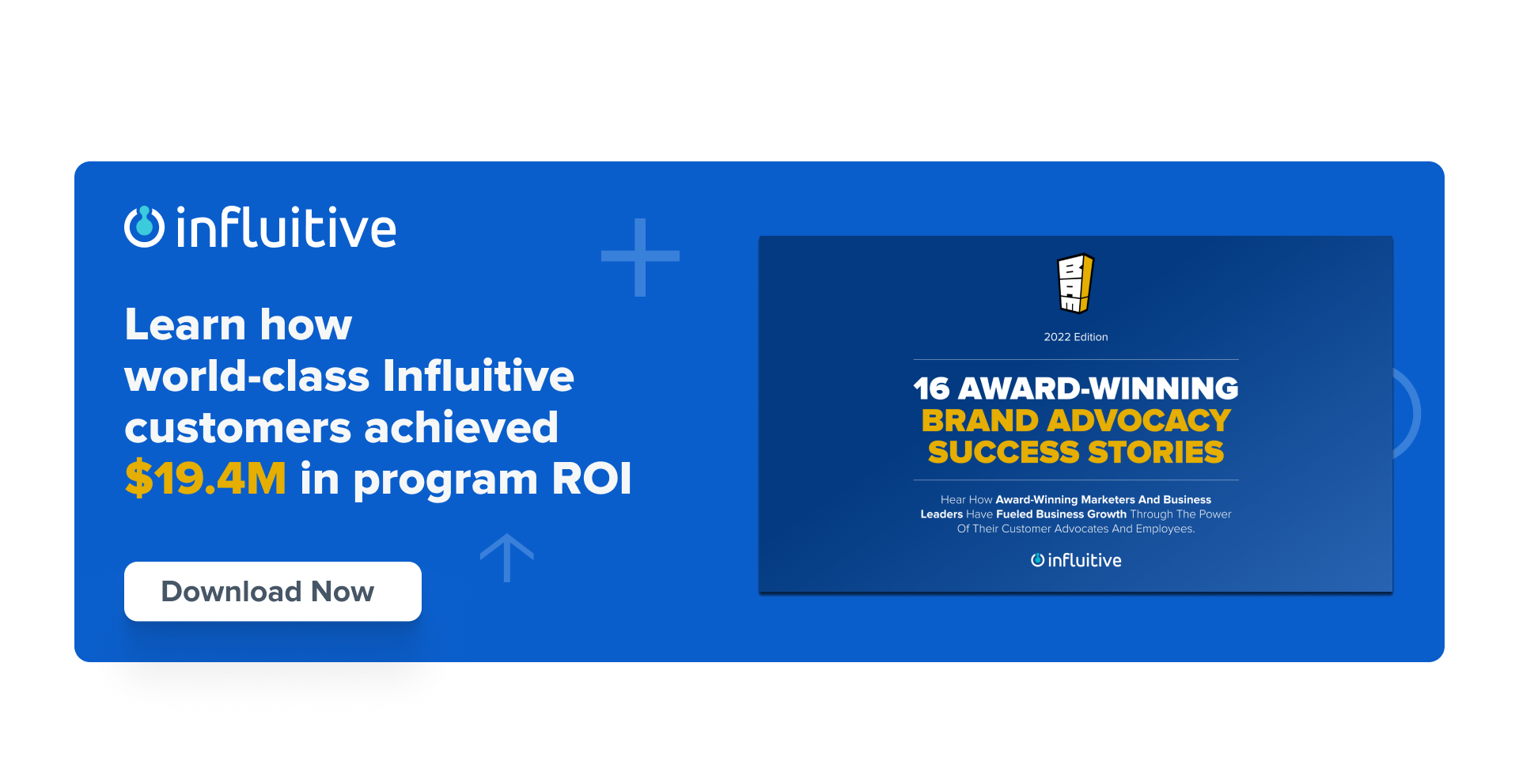When starting (and managing) a customer advocacy program, you’ll need to set customer advocacy KPIs or metrics. Doing so will help ensure you stay on track to succeed and maintain (if not grow) executive/leadership buy-in for your program.
In this blog post, we’ll walk you through goal-setting and measuring across 9 customer advocacy KPIs.
What is Customer Advocacy?
Ari Hoffman (VP of Customer Marketing and Advocacy at Influitive) defines customer advocacy as, “anything your customers do for you that’s not in their job description.”
For a deeper understanding of what customer advocacy is and how to build a customer advocacy program, we recommend reading Ari’s guide.
Customer Advocacy Metrics and KPIs

1. Customer Satisfaction Score (CSAT)
A CSAT score measures whether your customer is pleased when they make a purchase or interact with your brand.
CSATs are a fairly straightforward customer advocacy metric to gauge the happiness of your customers. So, when launching a program, you’ll want to see if your CSATs are going up and to what degree through the course of your efforts.
You can get a CSAT score by sending a CSAT survey to your customer after they interact with your brand. For example, you’d send a survey following a transaction, resolved a support ticket, when a product has been used for a defined period of time, and so on.
A “good” CSAT score will vary based on your industry. However, the “gold standard” for CSAT scores is generally 80% or higher.
2. Net Promoter Score (NPS)
The Net Promoter Score (NPS) is an effective way of gauging how your customers view your companymeasuring customer loyalty to your brand.
With NPS surveys, you’re typically segmenting your customers into the following:
Promoters (9 or 10)
You’ll find brand advocates from among these customers. They’re already your most loyal users and vocal fans who’ll promote your products and services to audiences. These customers could also be a healthy channel of referrals and references.
Passives (7 or 9)
While these customers are satisfied, there’s a risk of churn. Basically, they have a neutral and non-committal connection with your brand and offerings.
With a customer advocacy program, you’ll want to see customers go from being Passives to becoming Promoters. One of the earlier signs of progress is to see customer lifetime value or CLVs grow from the time you start customer advocacy.
Detractors (0-6)
These are your unsatisfied customers. With Detractors, you’re not only dealing with high churn rates, but potentially negative advocacy (e.g., poorly scored reviews).
You’ll notice that improving NPS scores requires work from across your internal teams, not just those managing customer marketing and advocacy. Everything from the quality of your offering to customer success to customer support and others will impact NPS scores.
3. Reviews and Testimonials
A positive outcome of customer advocacy is the velocity and quality of customer reviews and testimonials. So, as a customer advocacy KPI, you’ll want to see more of these assets and in greater quality so that they drive more lead gen and sales impact.
In terms of quality, you’ll want reviews that show credibility – i.e., customers who’ll leave their names, roles, companies, and specific benefits from using your products/services. The more detailed and authentic the reviews are, the stronger the impact.
In terms of velocity, you’re gauging how often customers respond to your requests for reviews and testimonials. Has the time, cost, and effort of getting strong customer perspectives decreased since launching your program?
This is a critical customer advocacy KPI because it ties into the fact that buyers want to hear from trusted people. They don’t care about ads or salesly copy.
4. Social Listening
Social listening (or social media listening) is the strategy of monitoring your social media channels for brand presence and sentiment. You’re tracking who’s mentioning your brand, products and services, competitors and other keywords.
Basically, social listening opens a window into how your customers and prospects really feel about your company. It also helps you gauge if you’re “on the map” on social media.
One of the customer advocacy KPIs you want to see is if your brand is becoming more prominent on your target platforms, like LinkedIn, Facebook, and Twitter. How often is your brand name showing up in key industry hashtags? Are your own hashtags (for campaigns, events, etc.) coming up more often?
5. Social Media Interactions
One valuable customer advocacy KPI is program impact on your social media activities.
So, for example, if your sales team is carrying out a social selling strategy to boost closing rates, see if audiences and customers are engaging your sales reps. Is your team seeing more Likes? Are they leading more conversations from their LinkedIn posts?
More broadly, see if you’re driving more reach and engagement on your target social platforms. In other words, is your thought leadership content getting more shares? Are you seeing a boost in web traffic from social? Have your employees reported more comments on their social posts?

6. Customer Engagement
Next, look for growth in customer responses to your initiatives, campaigns, and requests.
For example, are more customers signing up for a beta build of a future software release? Is the percentage of customers responding to your CSAT and NPS surveys increase? Do you see more customers become members of your community?
7. Revenue Growth via Customer Referrals and Retention
These customer advocacy KPIs will matter significantly when seeking leadership buy-in for your program. The metrics directly tie into your company’s bottom line.
Carefully look at both the velocity and quality of customer referrals. You want the number of referrals to go up, but your sales team should also be closing them at a higher rate.
Next, gauge how much revenue growth you’re getting from your existing customers. This is a golden opportunity as it costs much less to keep a customer than to get a new one. And just a 5% increase in customer retention can drive 25-95% more profit.
8. Reduced Support Costs
See if your customer advocacy program is helping take the load off your customer support team.
Basically, one impact of active customer advocates is that they can help answer questions from their peers and guide your users with troubleshooting, solving problems, etc.
For example, Trimble Viewpoint reduced support tickets by 30% through customer advocacy.
9. Product Adoption, Feedback and Improvement
A strong customer advocacy program can sharpen your product development. You’ll get more and higher quality feedback about your product and services. You can also close gaps in your feature-set and tools by leaning on what your customers tell you.
To measure customer advocacy metrics in the product team, Wiley set KPIs like the number of feedback surveys completed and saved hours of research.












































